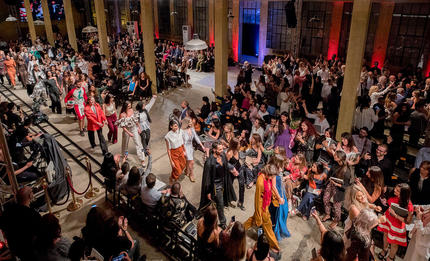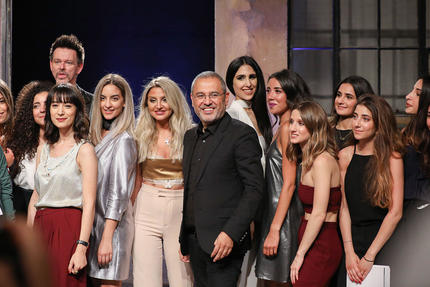Eclectic show reveals exceptional work by LAU’s premier fashion graduates
Impressive outfits showcased in front of Elie Saab, London College of Fashion representatives, dignitaries, fashionistas and proud parents.
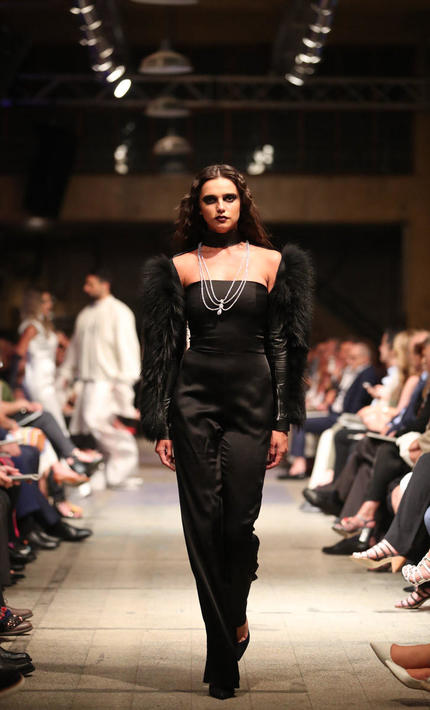
Storytelling was the approach used by Alia Malass, resulting in a cohesive and sophisticated collection.
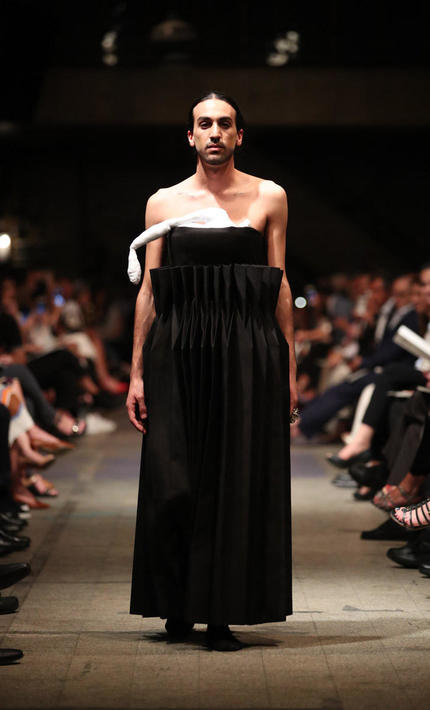
Through complex pattern cutting Dana Agal’s collection for men and women reinterprets mental health and perceptions of reality issues.
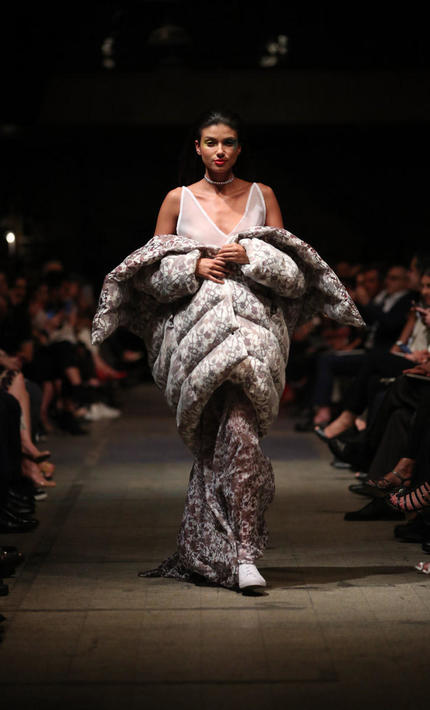
Venice Beach, the 90’s and vintage family photographs ensured Joya Haddad’s collection stood out for its fragility.
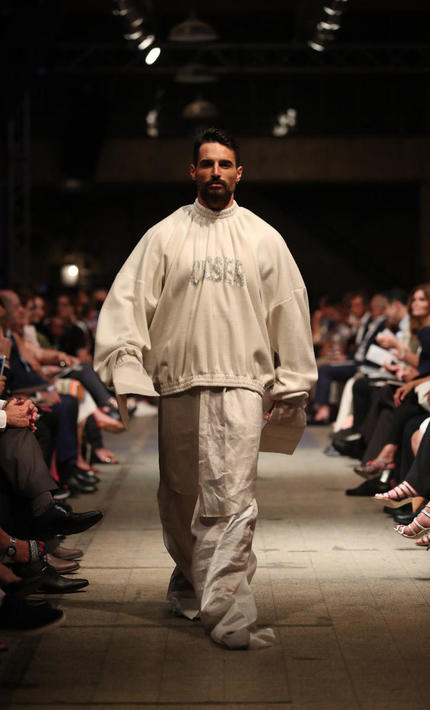
Prix du Jury winner Dania Mahdi’collection highlights the hardships faced by Syrian refugees as they travel by sea to land on safer shores.
The 160 outfits modeled at last night’s extravagant fashion show, held in a disused textiles factory in the outskirts of Beirut, projected a Lebanon that is vibrant, eclectic, energetic, joyful and above all adventurous.
“We don’t do fashion; fashion is a reflection of society,” said Jason Steel, coordinator of LAU’s fashion design program, ahead of the show put on by the first cohort of graduates.
Steel has for four years been nurturing the curiosity and creativity of the 16 designers whose first collections were showcased, leading them on a journey of self-discovery and expression.
The students, now graduates, were supported in their individual journeys by the program’s honorary chair, internationally renowned Beirut-based designer Elie Saab, and the expertise of the London College of Fashion (LCF). The trailblazing Bachelor of Arts in Fashion Design in collaboration with ELIE SAAB and the London College of Fashion was initiated in 2013, aiming to help bolster and redefine Lebanon’s fashion industry.
In one of the large rooms of the Abroyan factory, decked out with rows of seats along a rectangular runway that spanned the entire area, LAU President Joseph G. Jabbra, Saab and head of LCF Frances Corner were joined by ministers, ambassadors, academics, and proud parents to celebrate the achievements of the young fashion designers.
“They ceased being students in the final year when they completely focused on their individual and unique vision, to become who they are,” said Steel of his former students. “This show is the launch pad for these creative entrepreneurs, who will change the cultural identity of the country,” he said.
The garments on show — ten outfits per designer — were eclectic and were not limited to the eveningwear look Lebanese designers are known for.
“Fashion is not only about women’s wear and glamorous bridal dresses but is also about menswear, sportswear, knitwear and textile experimentation,” said Yasmine Taan, chair of the Department of Art and Design, in her welcoming remarks.
The 160 pieces, showcased by 60 models, included a collection of outfits designed for the Lebanese 2020 Olympic team, disco-inspired leotards and body suits, a man’s jump suit masquerading as a trench coat, a series of deconstructed blazers, oversized jackets, track suits and knitted ponchos, and embroidered wrap coats that resembled duvets.
“Some of the outfits are very conceptual and experimental and others are ready to sell,” said Director of International at the London College of Fashion Paul Yuille, clearly pleased with the results of the partnership with LAU and ELIE SAAB.
“While LAU adopts a U.S. model and international standards, it has a very evident local culture, and we found this very attractive,” said Yuille of LCF’s decision to partner with LAU. “Preserving and enhancing local culture and expression is key, and the fact that ELIE SAAB was both established and remains in Lebanon is hugely significant and aspirational for young Lebanese designers,” he said.
The desire to give back to his country is what motivated Saab, a self-taught designer, to establish an academic program. “I wanted to share my experience and knowledge with the overflowing pool of young talent that is just waiting to burst into life,” said Saab ahead of the inaugural fashion show.
“The difficulty had been to set up a structured platform where students can study, learn and perfect the right skills they need to attain degrees of international standards,” said Saab, expressing his appreciation at a dream fulfilled.
Jabbra also thanked Saab for his vision and commitment to Lebanon’s youth and said to the graduates, “It is quite moving to see that your dream is being realized right at this moment.”
“We are saddened by your impending departure. Our only consolation is that you will soon be our beloved alumni and will go out into the world to have a brilliant career and make major contributions to society,” he said.
Among those planning on strengthening Lebanon’s fashion industry is Hiba Kawoukji, whose collection reflected her love for dance and was inspired by the attitude of the 1980s woman.
“I’m not ready to launch my own label yet, so I’ll gain some experience first before returning to Lebanon to help build the fashion industry here,” said Kawoukji.
“We are so lucky to have enjoyed this degree and this amazing show, and as the pioneers we’ll build the industry and the opportunities so that future graduates won’t have to go abroad to gain work experience,” she added.
Kawoukji, like her peers, was incredibly grateful for the opportunity to be showcased in a fashion show of international standards. “This location is amazing and gives off a New York vibe. It’s a perfect neutral space for us — designers with different styles and expressions — to present our wears,” she said of the factory located in Beirut’s Bourj Hammoud district.
“I have walked in many professional shows in Lebanon and this is just as creative and professional,” said model Michael Kebabe, wearing a long black coat with a grey tribal print created by Karen Bou Alwan.
“The emphasis has been on craftsmanship and high quality,” said Steel, visibly moved and delighted. “There are many intellectual collections in there.”
As creative director of the show, he chose music that “represents the joy and beauty of Beirut in the summer and I pictured it being played in a factory that once produced garments, with people laughing and enjoying life,” said Steel.
More
Latest Stories
- LAU Family Medicine Graduates to Benefit from a Partnership With Nova Scotia
- AKSOB Assistant Professor Shares Her Vision for the Future of Learning
- LAU Simulation Models Celebrate 20 Years of Learning, Leadership and Service
- The School of Engineering Hosts the Lebanese Electromagnetics Day
- LAU Stands Out on the Sustainability Scores
- Michael Haddad Walks Again for Climate Change and Food Security
- AI in Clinical Practice: Tools, Ethics, and the Human Touch
- Interior Design Students Honor the Past by Designing the Future


